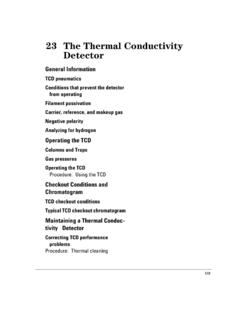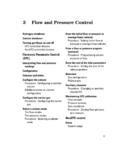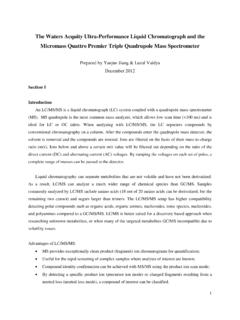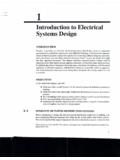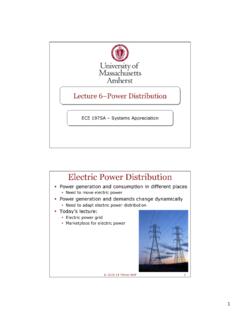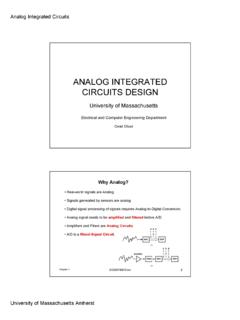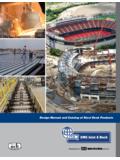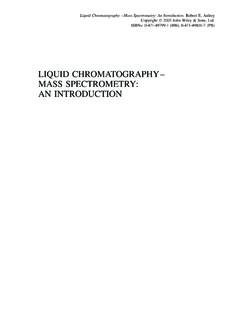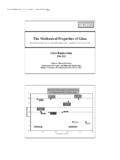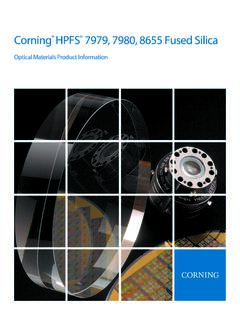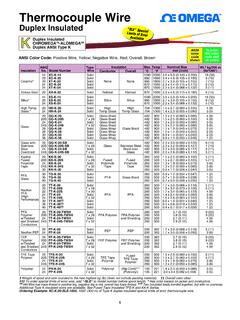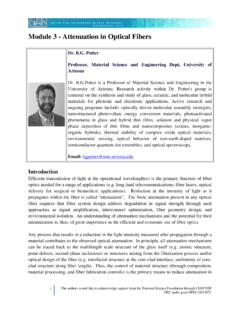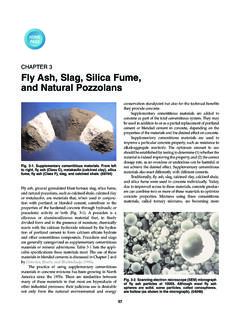Transcription of Gas Chromatography - UMass Amherst
1 Gas Chromatography Rosa Yu, David Reckhow CEE772 Instrumental Methods in Environmental Analysis Print version CEE 772 #16 1 Contents The primary components to a GC system Gas System (including Gas Clean Filters) The concept of theoretical plates and van Deemter curves Selection of proper carrier gas Introduction System Split & splitless injection (most critical component) Column configurations: packed vs. open tubular/capillary Stationary phase System/GC Detectors Types of detectors and their specific applications ChemStation/Integrator CEE 772 #16 2 The Basic Components to a GC System Carrier Gas Gas Clean Filter Injection Port GC Column Detector Integrator CEE 772 #16 3 Contents The primary components to a GC system Gas System (including Gas Clean Filters) The concept of theoretical plates and van Deemter curves Selection of proper carrier gas Introduction System Split & splitless injection (most critical component) Column configurations: packed vs.
2 Open tubular/capillary Stationary phase System/GC Detectors Types of detectors and their specific applications ChemStation/Integrator CEE 772 #16 4 I. Carrier Gas System Type of carrier gas effect on column efficiency and resolution H2/He/N2 Selection of carrier gas linear velocity/column flow rate Gas clean filter Pressurized cylinder/Gas generator CEE 772 #16 5 Type of Carrier Gas Effect on Column Efficiency and Resolution Selection of carrier gas: H2 > He > N2 (> Argon) H2 should be applied with safety precautions CEE 772 #16 6 Optimizing Linear Velocity/Flow Rate for High Column Efficiency van Deemter Plot CEE 772 #16 7 Optimizing Linear Velocity/Flow Rate for High Column Efficiency van Deemter Plot CEE 772 #16 8 Gas Clean Filter Significant damages can be done to the column if it is heated above 70 C with even trace amounts of O2 in the column Use carrier gas that meets the specification (UHP grade) Use O2 & moisture traps CEE 772 #16 9 Contents The primary components to a GC system Gas System (including Gas Clean Filters) The concept of theoretical plates and van Deemter curves Selection of proper carrier gas Introduction System Split & splitless injection (most critical component) Column configurations: packed vs.
3 Open tubular/capillary Stationary phase System/GC Detectors Types of detectors and their specific applications ChemStation/Integrator CEE 772 #16 10 II. Sample Introduction The sample must be of a suitable size (especially for WCOT/capillary columns) and introduced instantaneously as a PLUG OF VAPOR Slow injection/oversize causes peak broadening and poor resolution CEE 772 #16 11 Types of GC samples and injection methods Liquid Gas Solid CEE 772 #16 12 Auto Sampler Automation Up to 150 samples Instantaneous injection Same amount of sample injected every time CEE 772 #16 13 Injection Port Packed Column Injector CEE 772 #16 14 Split vs. Splitless Injection Splitless injection For example, a liquid sample is injected into the port, it is quickly volatilized at the end of the microsyringe and at the head of the column; the solutes are then taken by the carrier gas into the column Split injection Open tubular/capillary columns usually have a much smaller cross- section area than that of packed columns.
4 This makes them more subject to extra-column band-broadening, requiring that special low volume injection techniques be used with them. Packed bed open tubular plug of solutes Volume of injector CEE 772 #16 15 Sample Splitter The sample is first placed into the injection port and is vaporized As the sample leaves the inject port, only a small portion of the vaporized samples is applied to the column (usually 1/50 to 1/500), with the remainder going to waste (by opening the purge valve/split vent). glass frit/ wool CEE 772 #16 16 * Cold On-Column Injector Cold on-column injectors involves direct injection of a sample onto a column at low temperature. No heated injection port is used. The low initial column temperature increases the retention of all solutes and concentrates them at the top of the column in a narrow plug. The column temperature is then increased, allowing the solutes to volatilize and be separated. CEE 772 #16 17 *Programmed temperature vaporizer (PTV) A programmed temperature vaporize involves placing sample into a cold injection port, where it is then heated and applied to column at any desired temperature.
5 A universal injector for open-tubular columns since it temperature program may be changed so that it can be used either in cold injectors, splitless injectors, or split injectors. CEE 772 #16 18 Contents The primary components to a GC system Gas System (including Gas Clean Filters) The concept of theoretical plates and van Deemter curves Selection of proper carrier gas Introduction System Split & splitless injection (most critical component) Column configurations: packed vs. open tubular/capillary Stationary phase System/GC Detectors Types of detectors and their specific applications ChemStation/Integrator CEE 772 #16 19 III. GC Column (heart of a GC system) Column configurations: packed vs. open tubular/capillary columns Stationary phase Film thickness and column efficiency CEE 772 #16 20 The Heart of GC CEE 772 #16 21 The Heart of GC CEE 772 #16 22 1. Types of GC columns (GLC) CEE 772 #16 23 1. Types of GC columns (GLC) CEE 772 #16 24 Packed GC Columns Stationary phase Less ubiquitous application: fixed gas analysis Lower column efficiency than that of capillary columns (smaller in length) Larger sample capacity CEE 772 #16 25 Particle Size of Supports The efficiency of a gas chromatographic column increases rapidly with decreasing particle diameter of the packing.
6 The pressure difference (head loss) required to maintain an acceptable flow rate of carrier gas, however, varies inversely as the square of the particle diameter; the latter relationship has placed lower limits on the size of particles used in GC because it is not convenient to use pressure differences that are greater than 50 psi. CEE 772 #16 26 Open Tubular/Capillary GC Columns Stationary Phase Most widely used High column efficiency (large number of theoretical plates due to long column length, up to 100 m) Small sample capacity (split sample inside inlet) CEE 772 #16 27 Open Tubular/Capillary GC Columns fused silica --pure form of glass that is very inert but fragile Polyamide--provides great mechanical strength and flexibility CEE 772 #16 28 Open Tubular/Capillary Columns CEE 772 #16 29 Packed vs. Capillary CEE 772 #16 30 Packed vs. Capillary CEE 772 #16 31 2. Stationary Phase Important Attributes volatility (boiling point at least 100 C higher than max.)
7 Column operating temperature) stability (wide temperature operating range) inertness (non-reactive to both solutes and carrier gas) characteristics (differential solvent for different components) CEE 772 #16 32 Qualitative Guidelines for Stationary Phase Selection Sources: Literature review, Internet search, prior experience, advice from a vendor of chromatographic equipment and supplies General rule: like dissolves like Like refers to the POLARITIES of the analyte and the immobilized liquid The polarity of a molecule, as indicated by its dipole moment, is a measure of the electric field produced by separation of charge within the molecule Polar functional groups: -CN, -CO, -OH, -COOH, -NH2, -CHO, -X, etc. Nonpolar function groups: saturated alkane CH, etc. CEE 772 #16 33 Types and Polarities of Stationary Phase OSiCH3CH310"X"- 1 OSiCH3CH3 OSi95%5%"X"- 5 Polydimethyl siloxane backbone Phenyl substitution of methyl groups Polarity CEE 772 #16 34 Types and Polarities of Stationary Phase CEE 772 #16 35 3.
8 Effect of Film Thickness on Column Efficiency CEE 772 #16 36 3. Effect of Film Thickness on Column Efficiency Peak Fronting CEE 772 #16 37 Packed vs. Capillary CEE 772 #16 38 Contents The primary components to a GC system Gas System (including Gas Clean Filters) The concept of theoretical plates and van Deemter curves Selection of proper carrier gas Introduction System Split & splitless injection (most critical component) Column configurations: packed vs. open tubular/capillary Stationary phase System/GC Detectors Types of detectors and their specific applications ChemStation/Integrator CEE 772 #16 39 IV. GC Detection Systems/Detectors CEE 772 #16 40 Characteristics of the Ideal Detector sensitivity (application specific, adequate for certain tasks) stability and reproducibility linear response to solutes that extends over several orders of magnitude (calibration purposes) wide temperature range short response time independent of flow rate reliability and ease of use (unfortunately, usually not the case ) in response toward all solutes/most classes of solutes detector should be nondestructive S/N >3 CEE 772 #16 41 Typical GC Detectors Universal detectors CEE 772 #16 42 1.
9 Flame Ionization Detector (FID) Most common detector for GC In an FID, effluent from the column is directed into a small air-hydrogen flame. Most carbon atoms (except C=O) produce radicals (CHO+) in the flame: CH + O CHO+ + e- Electrons are used to neutralize the CHO+ atoms and the ions are collected at an electrode to create a current to be measured. This current is proportional to the number of molecules present. The ionization of carbon compounds in the FID is not fully understood, although the number of ions produced is roughly proportional to the number of reduced carbon atoms in the flame. CEE 772 #16 43 Pros and Cons of FID Advantages: detector for organics not respond to common inorganic compounds phase impurities not detected gases not detected of detection: FID is 1000x better than TCD and dynamic range better than TCD Disadvantage: destructive detector CEE 772 #16 44 2. Thermal Conductivity Detector (TCD) One of the earliest detectors of GC The device contains an electrically heated source whose temperature at constant electrical power depends on the thermal conductivity of the surrounding gas.
10 Twin detectors are usually used, one being located ahead of the sample-injection chamber and the other immediately beyond the column. The bridge (Wheatstone bridge) circuit is arranged so that the thermal conductivity of the carrier gas is canceled. element CEE 772 #16 45 2. Thermal Conductivity Detector (TCD) The thermal conductivities of helium and hydrogen (commonly used carrier gases for TCD) are roughly 6~10 times greater than those of most organic compounds. Thus, even small amounts of organic species cause relatively large decreases in the thermal conductivity of the column effluent, which results in a marked rise in the temperature of the detector. Advantages: Simplicity, large linear dynamic range, nondestructive Disadvantages: Low sensitivity (precludes their use with WCOT columns with small amounts of sample) Twin detectors CEE 772 #16 46 3. Electron Capture Detector (ECD) Radioactive decay-based detector Selective for compounds containing electronegative atoms, such as halogens, peroxides, quinones, and nitro groups The sample effluent from a column is passed over a radioactive emitter, usually 63Ni.
